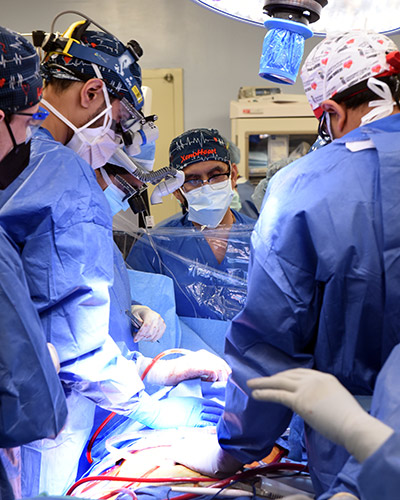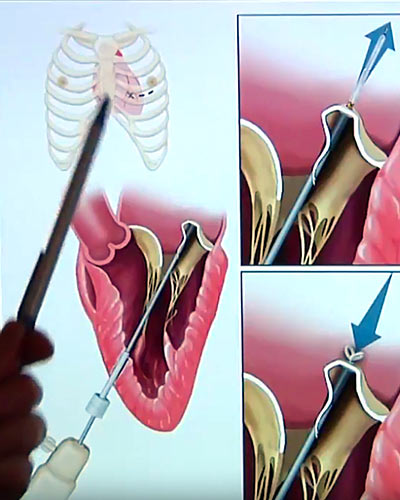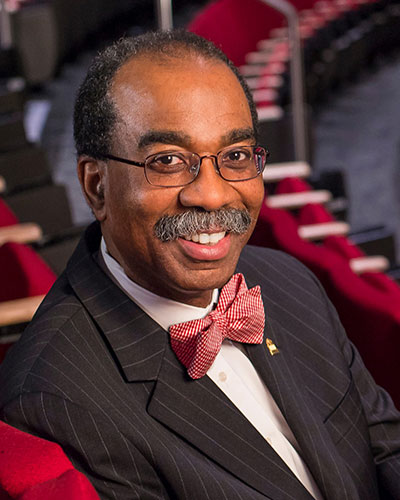July 20, 2018 | Bill Seiler

Study Shows Earlier Surgery Gets Better Results
Patients who receive early heart surgery to correct mitral valve problems survive at the same rate as patients without heart disease. However, a new study has found that many patients are referred for surgery too late, after they have already suffered heart or lung damage. The major contributor to surgical delays, the researchers say, may be lack of awareness and education on the part of doctors about alternatives to open-heart surgery.
The study, led by James S. Gammie, MD, professor of surgery at the University of Maryland School of Medicine (UMSOM) and chief of cardiac surgery at the University of Maryland Medical Center, found patients referred for mitral valve (MV) surgery often had heart failure, impaired ability to pump blood and heart rhythm abnormalities, conditions that may compromise long-term survival.
“The key challenge in mitral valve surgery is timing—correcting the problem before permanent damage occurs,” says Dr. Gammie. “Our study shows there’s a substantial opportunity to increase long-term survival of patients with mitral valve disease by following established guidelines and encouraging earlier referral for operation.”
Several factors may account for delayed MV surgery, including the severity of symptoms. “Mitral valve symptoms often progress slowly over four or five years,” says Dr. Gammie, while symptoms related to the aortic valve, also in the heart, often occur rapidly, drawing attention.
Dr. Gammie also speculates that some patients with mitral disease have not been considered surgical candidates. “My prediction is that the availability of less invasive therapy will raise awareness and will encourage referral of patients in the future that are at present deemed to be too risky for conventional surgery by their cardiologists and primary care physicians,” says Dr. Gammie.
Rachael W. Quinn, PhD, manager of the UMSOM Valvular Heart Disease Research and Innovation Laboratory, distilled information from an enormous data trove to form the analysis. “It was surprising to see that we’re still working on ways to get patients in to see their doctors and get the proper referrals to treatment,” says Dr. Quinn, the paper’s senior author. “The study helps us see the current state of mitral valve surgery and how it’s changing. We can use the information to help shape the direction of mitral valve surgery in the future.”
The mitral valve—one of four valves in the heart—prevents blood from flowing backward into the left atrium and lungs. Mitral valve diseases may cause shortness of breath, fluid retention, fatigue and lightheadedness. MV surgery can reduce symptoms of heart failure, prevent or reverse unhealthy changes in the size, shape, structure or function of the heart, and decrease death rates among people with severe mitral disease.
The study, published in The Annals of Thoracic Surgery, analyzed The Society of Thoracic Surgeons Adult Cardiac Surgery Database, a repository for more than six-million surgical records, encompassing data from adult cardiac surgery centers across the country and throughout North America.
The researchers identified more than 87,000 patients at 1,125 centers in North America who had undergone primary MV operations from July 2011 to September 2016. The average age of patients in this group was 64; half were female.
MV surgery is the fastest-growing surgical intervention in the database, according to the analysis, with the volume of isolated MV operations up 24 percent during the study period, and a subset of MV operations for degenerative leaflet prolapse up 44 percent. Conventional MV surgery is very safe, with a low risk of death or complications.
During the period under study, about three quarters of patients underwent a conventional breastbone-splitting procedure, whereas 23 percent underwent less invasive procedures.
“This study provides a critical snapshot of conventional, open-heart, on-heart bypass mitral valve surgery in the United States today,” says E. Albert Reece, MD, PhD, MBA, executive vice president for medical affairs at the University of Maryland, the John Z. and Akiko K. Bowers Distinguished Professor and dean of UMSOM. “It will help both scientists and clinicians, and will serve as a benchmark for comparison with newer, less invasive therapies as they are more widely adopted.”
Funding for this analysis was provided by The Society of Thoracic Surgeons through the Access and Publications Committee, as well as through Divisional Funding at the University of Maryland School of Medicine.
Publication
Gammie JS, Chikwe J, Badhwar V, Thibault DP, Vemulapalli S, Thourani VH, Gillinov M, Adams DH, Rankin JS, Ghoreishi M, Wang A, Ailawadi G, Jacobs JP, Suri RM, Bolling SF, Foster NW, Quinn RW. “Isolated Mitral Valve Surgery: The Society of Thoracic Surgeons Adult Cardiac Surgery Database Analysis.” Annals of Thoracic Surgery https://doi.org/10.1016/j.athoracsur.2018.03.086
About the University of Maryland School of Medicine
Commemorating its 210th Anniversary, the University of Maryland School of Medicine was chartered in 1807 as the first public medical school in the United States. It continues today as one of the fastest growing, top-tier biomedical research enterprises in the world -- with 43 academic departments, centers, institutes, and programs; and a faculty of more than 3,000 physicians, scientists, and allied health professionals, including members of the National Academy of Sciences, and a distinguished recipient of the Albert E. Lasker Award in Medical Research. With an operating budget of more than $1 billion, the School of Medicine works closely in partnership with the University of Maryland Medical Center and Medical System to provide research-intensive, academic and clinically-based care for more than 1.2 million patients each year. The School has over 2,500 students, residents, and fellows, and nearly $450 million in extramural funding, with more than half of its academic departments ranked in the top 20 among all public medical schools in the nation in research funding. As one of the seven professional schools that make up the University of Maryland, Baltimore campus, the School of Medicine has a total workforce of nearly 7,000 individuals. The combined School and Medical System (“University of Maryland Medicine”) has a total budget of $5 billion and an economic impact of nearly $15 billion on the state and local community. The School of Medicine faculty, which ranks as the 8th-highest public medical school in research productivity, is an innovator in translational medicine with 600 active patents and 24 start-up companies. The School works locally, nationally, and globally, with research and treatment facilities in 36 countries around the world.
Visit medschool.umaryland.edu/
About the University of Maryland Medical Center
The University of Maryland Medical Center (UMMC) is comprised of two hospitals in Baltimore: an 800-bed teaching hospital – the flagship institution of the 14-hospital University of Maryland Medical System (UMMS) – and a 200-bed community teaching hospital, UMMC Midtown Campus. UMMC is a national and regional referral center for trauma, cancer care, neurocare, cardiac care, diabetes and endocrinology, women’s and children’s health, and has one of the largest solid organ transplant programs in the country. All physicians on staff at the flagship hospital are faculty physicians of the University of Maryland School of Medicine. At UMMC Midtown Campus, faculty physicians work alongside community physicians to provide patients with the highest quality care. UMMC Midtown Campus was founded in 1881 and is located one mile away from the University Campus hospital. For more information, visit www.umm.edu.
Contact
Department of Anesthesiology
(410) 328-6120 (phone)
(410) 328-5531 (fax)
newsletter@som.umaryland.edu
Media Contact: Bill Seiler (bseiler@umm.edu) 410-328-8919
Related stories

Monday, January 10, 2022
University of Maryland School of Medicine Faculty Scientists and Clinicians Perform Historic First Successful Transplant of Porcine Heart into Adult Human with End-Stage Heart Disease
In a first-of-its-kind surgery, a 57-year-old patient with terminal heart disease received a successful transplant of a genetically-modified pig heart and is still doing well three days later. It was the only currently available option for the patient. The historic surgery was conducted by University of Maryland School of Medicine (UMSOM) faculty at the University of Maryland Medical Center (UMMC), together known as the University of Maryland Medicine.

Friday, December 01, 2017
New Study: Innovative Heart Device is Safe and Effective
A new study has found that a pioneering device to repair heart valves is safe and effective, and can reduce the invasiveness and side effects of conventional mitral valve surgery. The Harpoon Mitral Valve Repair System (H-MVRS), an image-guided device based on technology developed at the University of Maryland School of Medicine (UMSOM), is deployed through a small opening between the ribs, and repairs the heart while it continues to beat. The research was presented at the Transcatheter Cardiovascular Therapeutics (TCT 2017) symposium in Denver, and simultaneously published in JACC, the Journal of the American College of Cardiology.

Tuesday, July 19, 2016
New Surgical Tool for Mitral Valve Repair Demonstrates Success in First Human Clinical Study
Researchers investigating a novel device to repair the mitral heart valve report 100 percent procedural success in a safety and performance study, the first such study done in humans. The image-guided device, based on technology developed at the University of Maryland School of Medicine, is deployed through a tiny opening in a beating heart, avoids open-heart surgery, automates a key part of the valve repair process, simplifies the procedure and reduces operating room time. The research is published in the journal Circulation.

Thursday, March 10, 2016
UM SOM Establishes Two Endowed Professorships Through Private Gifts and Matching State Funds
University of Maryland School of Medicine (UM SOM) Dean E. Albert Reece, MD, PhD, MBA, announced today that the School has been awarded matching funds from the Maryland Department of Business and Economic Development (DBED) as part of the Maryland E-Nnovation Initiative Fund program. The funds, when combined with private philanthropy, will enable UM SOM to establish two new endowed professorships – one in human virology and vaccine development, the other in surgical science and entrepreneurship.
